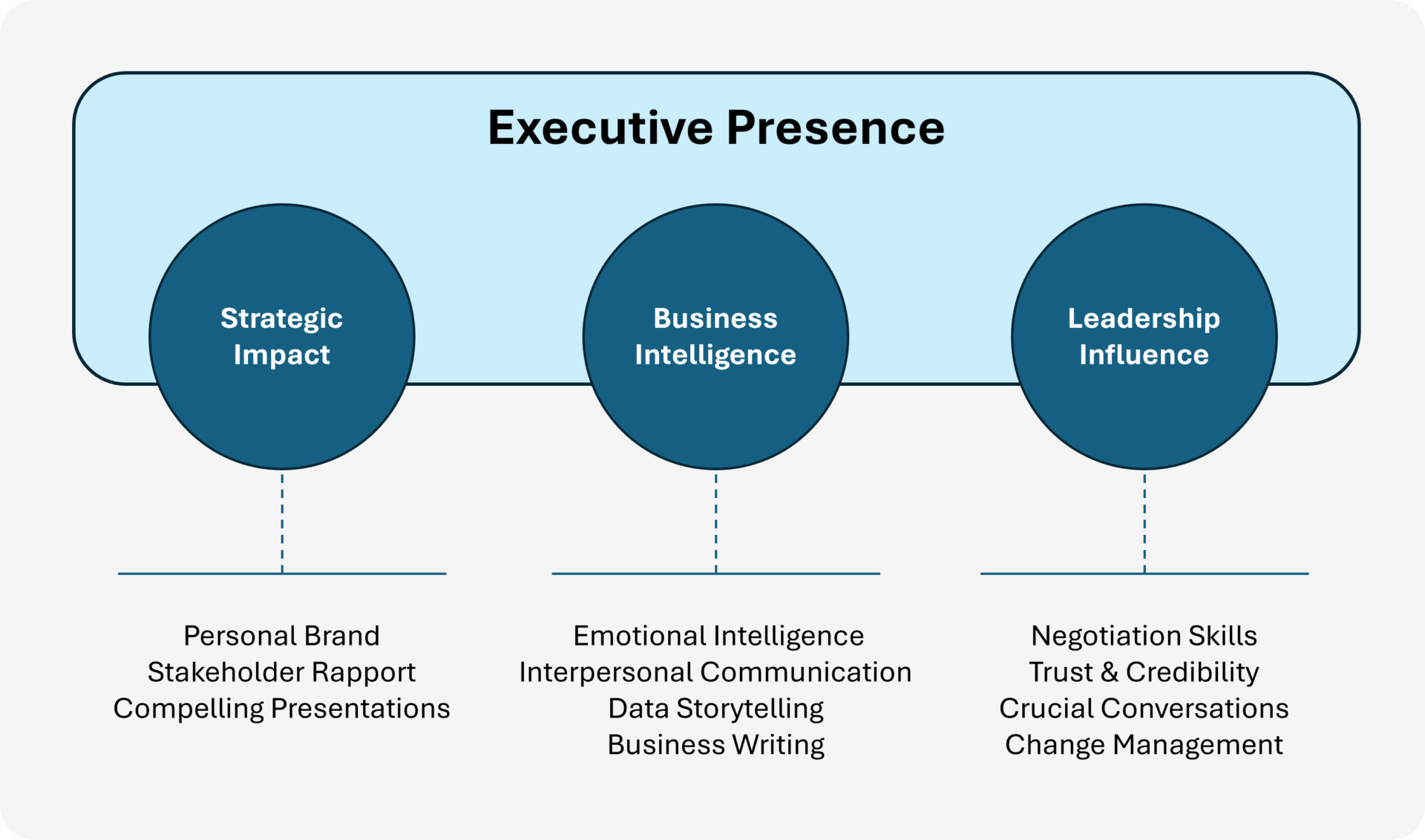Senior leaders are important and influential people within any organization. It’s necessary that they stay at the “top of their game” and are well-equipped with the capabilities needed to drive their organizations forward. In Part 1 of this series, we outlined why executive leadership development is so important for these individuals, their teams, and the organization and identified some common development needs. Part 2 addressed the unique challenges associated with creating and fielding development programs for senior leaders, offering some solutions along the way.
At the end of Part 2, we noted that a well-orchestrated communications strategy is essential to the success of any development program for senior leaders. Without that, senior leaders will likely be unclear on how to take advantage of a program or dismiss its value, resulting in low participation rates and minimal impact. In this installment, we address the key components of a good communications plan, unique challenges in communicating with senior executives, and some high-level solutions to those challenges.
Key Components of an Effective Communications Plan for Senior Leadership Development
An effective communication plan for any change initiative–which is what an Executive Leadership Development Program is–should have defined objectives, consider cognitive constraints in absorbing information, and be developed in stages.
Recommended objectives for a communication plan include the following:
- Communicate how the program is linked to business strategy and impact, and why it is a priority for the company
- Educate executives about why their development is critically important for themselves and why they should commit to participating in this program
- Clearly and concisely show how they should participate in the program, what they are supposed to do, and when
- Enable them to track their progress and see how others are doing
- Provide a platform to give the learners a voice and provide feedback
This might sound relatively straightforward, and perhaps accomplished by simply preparing and sending out a few emails. Unfortunately, that is exactly how fantastic programs fail to reach their potential. In any change initiative, there is usually a lot of important information to communicate, which often results in a mad rush to get the information out, neglecting the learners’ ability to process, internalize, and act on it. One must keep the learner at the center, and importantly, consider the ways in which cognitive constraints impact a human’s ability to absorb information.
The intricate processes of human memory can significantly impact one’s capacity to absorb and retain information. Working memory is often a bottleneck, as it restricts the amount of information that can be processed at a given moment. Moreover, encoding, which determines how information is initially registered, can be influenced by factors like attention, prior knowledge, and emotional state, affecting successful processing.
In addition, long-term memory storage, essential for retaining absorbed information over time, is impacted by the frequency with which information is processed and if the leader has elaborated or crafted meaningful associations during that processing. As our recommendations highlight, it is essential to account for the cognitive constraints all leaders have in a communications plan in order for leaders to first remember and then act on a development journey’s opportunities.
Finally, a communication plan is not a one-and-done deliverable. While back-of-the-napkin ideas are great and creativity should be fostered, developing, socializing, and deploying an effective communications plan typically follows five core stages:
- Define your audience and any additional stakeholders, and understand their priorities
- Develop key messages that are closely linked to the business and company context
- Identify the best tactics to communicate the key messages
- Develop a communication plan and validate with the right stakeholders
- Execute the communication plan, track progress, and improve on an ongoing basis
Objectives, awareness of cognitive constraints, and a solid development approach will put any communications plan ahead of the curve. That said, specific nuances and watch-outs should be incorporated and accounted for in communications plans that target senior executives.
Unique Challenges in Communicating with Senior Executives
Everyone is drowning in communications. Emails. Teams chats. Yammer posts. Slack streams. Not to mention LinkedIn articles, white papers. Reddit feeds, and on and on and on. Senior executives are no different – and in reality, likely even worse off.
Senior executives receive a very high number of communications.
Senior executives are the key drivers of a company’s vision and strategy, critical decisions, and change initiatives. Every internal stakeholder with a deliverable and a dream likely wants to inform, discuss or gain a senior leader’s input, advocacy or stamp of approval. It is impossible for a senior leader to read every communication. Hence they have Executive Associates and make choices or they would never sleep, not to mention achieve their business objectives.
Senior executives often don’t consume common communication channels.
In addition to receiving a boatload of communications, senior executives are often privy to privileged and confidential information that goes way above and beyond topics disseminated on common, all-access communications channels. Add in the reality that they are usually in meetings all day and travel frequently, and typical communication channels that cater to broad sections of the organization likely won’t be on their radar.
Senior executives have constantly changing agendas and priorities.
Lastly, in an era of a constantly changing external landscape, being a good leader requires the ability to quickly adapt and pivot. Senior executives have highly dynamic agendas that are continually reshaped by changing business needs. A priority today might not be one tomorrow. The value proposition of an Executive Leadership Development Journey must be continually measured against what senior leaders need at that moment, with clear links to current corporate priorities. If not, the journey risks becoming irrelevant, falling off senior executives’ crowded radars.
Best Practices when Communicating with Senior Leaders
Is communicating with senior leaders challenging? Yes. Is it impossible? No. Below are some recommendations to customize a communications plan for senior leaders to drive impact.
Get the C-suite to say it
Hearing messages from above goes a long way. Having the C-suite deliver the value proposition of an Executive Leadership Journey increases the likelihood the message is taken to heart. How to do this? Meet corporate communications.
Almost all C-suite members have a dedicated corporate communications team member. These individuals typically reside in the Corporate Affairs function, which can stand alone, be embedded within a public affairs or compliance function, or be a component of the executive leadership team. Along with many other responsibilities, corporate communications team members are responsible for coordinating, drafting, and approving the high visibility communications a C-suite member sends or delivers internally and externally. Their partnership and support is critical.
An L&D team should partner with the leadership communications team members to identify the optimal C-suite leader to advocate for the journey as well as the most appropriate content, platform, and timing for communications. A key here is to connect the value proposition, vision or objectives of the Executive Leadership journey to a C-suite member’s other priorities.
For example, if the Executive Leadership journey focuses on diversity and inclusivity capabilities, then the Chief Diversity and Inclusivity Officer would be key (note, this might be the CHRO). If driving innovation or new ideas is a focus, consider a Chief Research Officer or Chief Commercialization Officer. Connecting the Executive Leadership journey’s value proposition to a C-suite leader’s other organizational priorities creates a win-win for the C-suite member to participate and advocate for the initiative.
Engage the stakeholder groups close to the senior executives.
To increase the likelihood that a senior executive internalizes the what and why and acts on the how of a communications plan, it is important to engage the key individuals that surround a leader – their proverbial circle of trust. This includes the aforementioned Corporate Affairs team members and extends to the leaders’ Strategy and Operations team members, HR business partners, executive assistants and other company-specific roles that have linked priorities or regular touchpoints with senior leaders.
Finding and connecting with these individuals in a 30,000-employee global organization may seem daunting. Consider leveraging the Learning leadership team or the Chief Learning Officer to establish access and develop rapport. Investing the time to communicate the why, what, and how of the Executive Leadership journey pays returns in their championing and fostering the senior executives to engage in it.
Use highly effective and relevant content.
Following that senior executives are very busy people, they have little time to sift through verbosity. Content must be relevant, concise, and actionable. Asks should be at the forefront, not buried beneath the fold; content and key messages should be in alignment with business priorities.
Balance planning with agility.
All of the above requires planning, networking, and stakeholder management. L&D must identify the right stakeholders, understand their priorities, get on their calendars, gain their buy-in, and get their help in shaping the communication plan. With busy schedules, this takes a long time. That said, as mentioned, senior executives’ needs and priorities can change quickly. Just like their learners, the senior executives, an L&D team must remain flexible and agile throughout the lead up and execution of an Executive Leadership journey.
Effective communication is vital for the success of any senior leadership development program. Without a well-crafted communications strategy, even the most meticulously designed program will likely fail to engage senior leaders and drive meaningful impact. By following best practices such as partnering with corporate communications teams, engaging stakeholder groups close to senior executives, delivering concise and relevant content through effective channels, and maintaining agility to adapt to changing priorities, organizations can increase the chances of their senior leaders internalizing the value proposition and actively participating in the development journey. Ultimately, a thoughtful and comprehensive communications approach is essential for ensuring senior leaders stay at the top of their game and are equipped to drive their organizations forward in an ever-changing business landscape.





















